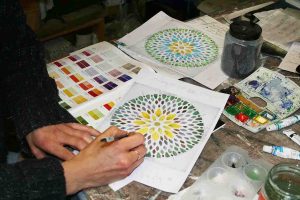
Jayne Ford is an award-winning artist specialising in decorative glass techniques, from traditional stained glass to garden sculpture and public art. Originally a successful biomedical research scientist, she revisited a lifelong interest in visual art in 2008 and enrolled at the International Glass Centre, Brierley Hill to study glass painting and stained glass.
In 2010 she set up a stained glass studio in Manchester (originally named Genesis Stained Glass) after undertaking a Worshipful Company of Glaziers Training Award at Pugin, Hardman and Powell Studio in Birmingham.
In 2014 she won the Stevens Architectural Glass Artist of the Year and the George and Evelyn Gee Award for Craftsmanship. She designed and made the inaugural Lord Mayors Roundel for the 2017 Reflections of the Lord Mayor event and continues to support the annual roundel competition as a member of the judging panel and provider of presentation glass artwork.

Artist Statement
“After a fifteen year career as a research scientist and project manager, I changed tack having kept up drawing, painting and making as a hobby. We choose our career directions pretty early on in life and it was a stark choice between art and science at the time when I chose my “A” Levels. Working in the biomedical sciences was a fulfilling occupation (there was never a dull moment!), and has given me many transferable skills, but I felt it was time to explore other avenues in life. I wanted to practice a craft, and I looked at ceramics, photography and stained glass before settling on glass painting as the skill I would develop further. I now work with most other fired glass techniques, perhaps drawn to the seemingly alchemical processes involved when heat-transforming such a unique substance. Opening the kiln is always exciting, especially when you’re trying something new.

I am equally at home designing and making intricate kiln-formed pieces, managing architectural projects such as large-scale digital printing, etching and ecclesiastical stained glass installations or facilitating hands-on creative group activities. At the studio we get asked to do an amazing variety of glass-work. For example, we can be working on a Pre-Raphaelite painted window one week and a decorative back-lit screen for a hotel the next. Often we can be working on several totally different projects at once, which is an aspect I really enjoy.

I make transparent kiln-formed and painted pieces that take elements of nature and extend them into a vitreous dimension of colour, refraction and reflection. Early life on earth, primitive life-forms and our place within the cycle of life are themes that I often return to. The unique properties of glass allow manipulation of both its surface and body. You can manipulate glass to produce organic forms with a sense of fragility but also bold, geometrical pieces that give the impression of strength and solidity. There is a dynamic interplay between reflection and refraction in sculptural, transparent glass that you just can’t get with other substances such as resins.
I feel fortunate to have worked in both science and the arts. To be a good artist and a good scientist, you need creative flair, technical ability and good communication skills; in fact both explain and reflect our world from different perspectives. However, I think art speaks more directly to most people and is a way of engaging people from all walks of life. The presence of beautiful artwork in our everyday environment improves psychological and hence physical well-being.”
